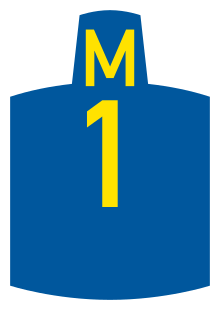M1 road (Johannesburg)
| |
|---|---|
| Route information | |
| Maintained by Johannesburg Roads Agency and Department of Roads and Transport (Gauteng) | |
| Length: | 18.5 mi (29.6 km) |
| Existed: | 1967 – present |
| Major junctions | |
| North end: |
|
|
Carr Street Uncle Charlies Interchange | |
| South end: |
|
| Highway system | |
| Numbered routes of South Africa | |
The M1 De Villiers Graaff motorway is a major freeway in Johannesburg, South Africa. The highway connects the southern areas (including Booysens, Eldorado Park and Soweto) with the city centre and extends further north through Sandton into the Ben Schoeman Highway towards Pretoria. Construction began in 1962 and resulted in the demolition of many properties and houses including numerous historical Parktown Mansions.[1]
History
Both the M1 and M2 motorways have their beginnings in a 1948 traffic planning scheme developed by the Johannesburg City Council and examined by American traffic engineering consultant Lloyd B. Reid in 1954.[2]:577 Two 10-year plan examined among other things the idea of new urban motorways and improving existing highways. The plan called for two motorways, one running East-West along the southern CBD and the other running to North-South on the western side of the CBD.[2]:577 The plan was linked to national and provincial governments plan by the National Transport Commission for the Western and Eastern Bypasses, the future N1 and N3 in northern Johannesburg.[2]:577
The plan for the original motorway began in Bramley at Corlett Drive and headed south through Killarney and Parktown before cutting through the ridge between the University of the Witwatersrand and the Milner Park Agricultural Showgrounds and then over the Braamfontein railway yards through Newtown to the East-West interchange.[2]:578 From there it would cross Crown Mines land and head southwards past Robertsham to another proposed interchange and future Western Bypass (N12) before ending at the beginning of the Kimberley Road.[2]:577
Ground was broken for the new North-South Motorway on 28 May 1962 by Transport Minister Ben Schoeman, Administrator of the Transvaal, F.H. Odendaal and Johannesburg Mayor, Keith Flemming, just north of the Braamfontein Yards, site of the first bridge on the elevated motorway.[2]:579 The first section would be opened in the CBD in 1967 and rest of the motorway between 1972 and 1974.[2]:579
A two three-lane motorway was planned with large medians for breakdowns, elevated in the Central business district (CBD) as it crossed the Braamfontein railway yards and then became a double-decker motorway south through to an interchange near Westgate were it met the East-West Motorway (M2).[2]:578 The speed limit was set at between 80 km/h (50 mph) in the city, increased to 100 km/h (60 mph) and was set to reach 110 km/h (70 mph) the further one proceeded from the CBD.[2]:578 The motorway is named after the white South African opposition leader and United Party head, Sir De Villiers Graaff.
Current route
The M1 officially starts at the Uncle Charlies Interchange with the N12 Southern Bypass in Ridgeway. It follows a route north towards the city and meets the M2 highway at the Crown Interchange (which is immediately south-west of the city centre). The M1 then proceeds north through the leafy northern suburbs of Johannesburg, and the industrial area separating Sandton and Alexandra. The highway's northern terminus is at the Buccleuch Interchange where it meets with the N1 Western Bypass and the N3 Eastern Bypass. The part of the M1 in Sandton, roughly between Corlett Drive and the Buccleuch Interchange is maintained by the SANRAL; with future plans of tolling for the highway. Signage and extra lanes have been upgraded in 2010 with the "Gauteng Freeway Improvement". While the section between Corlett Drive and a portion south of the CBD is maintained by the Johannesburg Roads Agency (JRA) with the remainder to the South also maintained by the provincial government . The northern section maintained by the Gauteng Provincial Government is also designated the P206-1 .
Speed limits, which are strictly enforced, change as one gets nearer to the centre of Johannesburg, from 100 km/h in the northern section, beginning at the Buccleuch interchange, finally dropping to 80 km/h near the city centre. South of the CBD, the speed limit again increases. Before an upgrade in 2012, the speed limit was 120 km/h on the provincial government maintained stretch in Sandton, dropping to 100 km/h as it ran through the Northern Suburbs of Johannesburg (from the start of the JRA maintained section before Corlett Drive). However, subsequent to rehabilitation work in 2012, the limit in the northern section was also dropped to 100 km/h.
Congestion
The M1 experiences significant traffic congestion during a typical rush hour. Several public transport systems, including bus rapid transit and the Gautrain railway system aim to alleviate some of the traffic on the M1.
